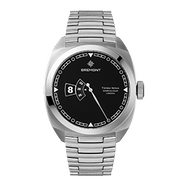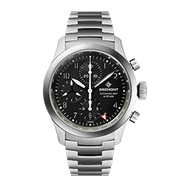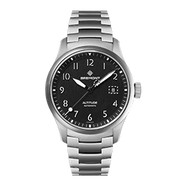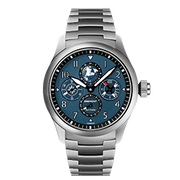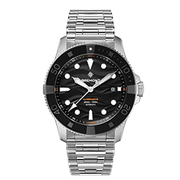Glossary
A
Anti-magnetic watches
Watches that continue to operate (with deviations under particular limits) when exposed to the influence of magnetic fields of a certain strength may be called anti-magnetic according to DIN.
Top of pageAnti-shock movement mount
A unique rubberised mount which encloses and secures the watch
movement in a case connected to the outer case solely by a flexible
ring. Shocks to the watch allow the movement case to float and absorb
much of the shock energy.
Automatic winding
This relates to a watch where the mainspring is wound by harnessing the movement of the wearer’s arm/wrist. These movements cause the rotor (an oscillating weight) to rotate and wind the mainspring.
Top of pageB
Balance
The balance works in combination with the balance-spring to regulate the rate of a mechanical watch. The balance usually comes in the form of a three-spoke wheel whereby oscillations are translated into the movement of the pallets via a small ruby pin (the impulse pin). In classical watch movements, the balance oscillates at a rate of 5 beats per second (bph), the equivalent to 18,000bph. To improve the precision, modern wristwatches have an increased rate of 19,800, 21,600, 28,800 or sometimes 36,000bph. In quality wristwatches, the balance is made of an alloy called Glucydur, a mixture of copper and beryllium and iron which has a hardness of 380 Vickers, allowing it to be carefully regulated and riveted in position. Temperature also has very little effect on this alloy.
Top of pageBalance spring
A spiral of ribbon-shaped metal, coiled 12 to 15 times, that ensures that the balance oscillates at a regular rate. The balance spring is securely fastened to the balance’s axis of rotation and delivers the braking and acceleration energies required to keep the balance rotating. Nivarox is the special alloy used for quality springs. Nivarox is an alloy that doesn’t rust, and is immune to magnetism and temperature.
Top of pageB-EBE2000
This is a special stage in the case production, in which the metal is bombarded with electrons to give the stainless steel a dramatically increased hardness and scratch resistance. On the Vickers scale of hardness, B-EBE2000 produces a watch case with a value of 2000, which is approximately seven times that of the normal stainless steel used for watch cases.
Top of pageBaselworld
Every year prestigious watch and Jewellery houses celebrate and showcase their new launches, creations and innovations at Baselworld, Switzerland. The show attracts press, retailers, and consumers and is widely known as the most important premier event in the watch industry calendar.
Top of pageC
Calibre
A term used to describe the form and/or size of a movement and often specifying the type of movement.
Top of pageChronograph
This pertains to a model of watch that displays hours, minutes and seconds, together with a mechanism for measuring elapsed time by means of a central chronograph hand which records seconds and totalisers for the minutes and hours.
Top of pageChronometer
A chronometer defines the accuracy and testing over an official 15-day series of tests by the official Swiss Chronometer testing institute, over a range of temperatures and five physical positions. The average daily deviation rate of the movement must be between –4/+6 seconds per day and only then can the movement be awarded as a chronometer.
Top of pageD
DLC
Black Diamond-Like Coated hardened stainless steel.
Top of pageDomed crystal
A convex pane of clear glass-like material (usually artificial sapphire) covering a watch’s dial.
Top of pageE
Escapement
Energy from the mainspring is retained by the escapement to help control the gear train. At the same time the escapement provides further energy to the balance spring where unavoidable losses due to friction are compensated. Contemporary wristwatches usually contain the pallet escapement which consists of the escapement wheel and its pinion.
Top of pageF
Faraday cage
A unique mechanism developed by Bremont consisting of a soft-iron housing in which the movement is cushioned, routing magnetic fields around the movement.
Top of pageFlyback
The Flyback function allows an ongoing time measurement to be interrupted and a new one to be started instantaneously by merely pressing a button. It combines three steps – stop, reset to zero and restart – into one. In chronographs without the Flyback function, these three steps must be executed consecutively. This function was originally invented in the early days of aviation. The concept behind the complex function dates back to the era when flight-deck crews still navigated with maps and watches and often had to react very quickly to suddenly occurring events.
Top of pageG
GMT
Greenwich Mean Time (GMT), or Zulu time (Z). is used as the standard clock of choice for international reference time in communications, military, aviation, maritime and other activities that cross time zones.
Top of pageI
Incabloc
A shock absorption system used in pocket and wristwatches.
Top of pageIndex (Adjustment)
A device which can be used to set the rate of a watch by changing the effective length of the balance spring in the oscillation system.
Top of pageJ
Jewels
To minimise friction in the most important bearings, jewels are fixed to the anchor pallets and ellipse. A movement with a large number of jewels does not necessarily mean that the movement is of particularly high quality.
Top of pageM
Mechanical watches
Watches that are powered by a mainspring whereby the oscillating system runs purely on a mechanical basis, e.g. balance or pendulum.
Top of pageMohs hardness scale
This scale was devised to divide the whole spectrum of hardness using a scale of 1 to 10. “1” stands for a very soft material (talcum) and “10” for the hardest material (diamond).
Top of pageMagnetism
This can occur when a watch is subjected to a magnetic field. A magnetic field can emit from a variety of different sources in day to day life. Computer hard drives, medical equipment, large speaker systems, refrigerator doors, magnetic tablet cases, mobile phones, magnetic catches on handbags to name a few can all emit magnetic fields. Magnetism may lead to excessive rate gain which can cause a watch to run fast or stop entirely. Magnetic fields do not cause permanent damage and minor intervention only is required to return your Bremont to it’s usual excellent standard.
Top of pageP
Power reserve
The maximum amount of time over which a mechanical movement can continue to run after its mainspring has been fully wound.
Top of pageR
Roto-Click®
Patented rotating bi-directional Roto-Click® inner bezel is an innovatively engineered ball-locking system containing a number of ball bearings that positions the bezel accurately for improved visibility.
Top of pageRotor
The oscillating mass which moves and turns freely about its axis in an automatic watch. The rotor winds up the mainspring as it swings. A clutch prevents the rotor from over-winding the mainspring.
Top of pageRetrograde
“Retrograde” is featured on the Bremont Victory and sweeps a segment of a circle before springing back to the initial position to begin the movement again.
Abraham-Louis Breguet used this type of retrograde mechanism in the late eighteenth century for functions such as the date or an equation of time. The Bremont Victory includes this complication and provides an aesthetically pleasing feature to any watch enthusiast.
Top of pageS
Sapphire crystal
Sapphire crystal is the favoured material for watch crystal due to its exceptional hardness (9 on the Mohs scale). Using sapphire crystal is far more expensive to manufacture than mineral or acrylic crystals, however sapphire crystal glass provides excellent scratch resistant properties.
Top of pageShock absorption
A system used to protect the very fragile pivots of the balance staff against breakage. The jewels for the pivots of the balance staff are elastically fitted to the main plate. In response to a severe shock, they give first. A watch with shock absorption properties should be able to meet the demands of DIN 8308-A. The testing includes the watch being hit by a hammer at 4.4m/s (equivalent of the watch being dropped from a one metre height onto a solid wooden floor). The watch must then not show a rate of deviation of more than +/- 60 seconds a day.
Top of pageStainless steel
An alloy of steel, nickel and chrome provides longevity and is extremely hard-wearing along with being favourable to the wearer.
Top of pageSuper‑LumiNova®
A luminous paint used on the dials of watch dial and does not display any radioactive properties. The luminous effect is based on the principle of phosphorescence. Super‑LumiNova® therefore needs to be charged by an external light source. As many as 15 to 20 coats of Super‑LumiNova® paint are applied to quality dials in very small measures to ensure that luminous dials are effective whilst not encroaching on the aesthetic qualities of a superior dial.
Top of pageT
Trip-Tick®
Trip-Tick® technology consists of 3 parts: the top bezel containing the sapphire crystal, the central body consisting of a middle barrel, and the steel or crystal back. For both longevity and aesthetics, the separate middle section allows our case designers to use differing constituents to alter the weight of the watch, and utilise contrasting colours offering variety between product styles.
Top of pageTitanium
Titanium is a metal component thats constituents provide low density and high strength. Titanium is light and comfortable for the Bremont wearer and has increased hypo allergenic qualities.
Top of pageU
UTC
UTC stands for ‘Universal Time Coordinated’ and allows the wearer to display local time together with the official world time standard – UTC, or Greenwich Mean Time (GMT), or Zulu time (Z). UTC (replacing GMT in 1972) is therefore used as the standard clock of choice for international reference time in communications, military, aviation, maritime and other activities that cross time zones.
Top of pageV
Vickers hardness
A common scale used to determine the hardness of a material (using a pyramidal diamond indenter). The impression created by the diamond on the surface is measured and the hardness calculated. Stainless steel, for example, ranges from 200 to 240 HV, titanium 210 HV, sapphire crystal 2000 HV and diamond 4500 to 10,000
Top of pageW
Water resistance
A pressure resistance of at least 10 Bar is guaranteed for every Bremont watch. This corresponds to the pressure of water at a depth of 100 metres statically tested. Water resistant properties cannot be permanently guaranteed and we therefore recommend that seals are checked annually.
Top of page





